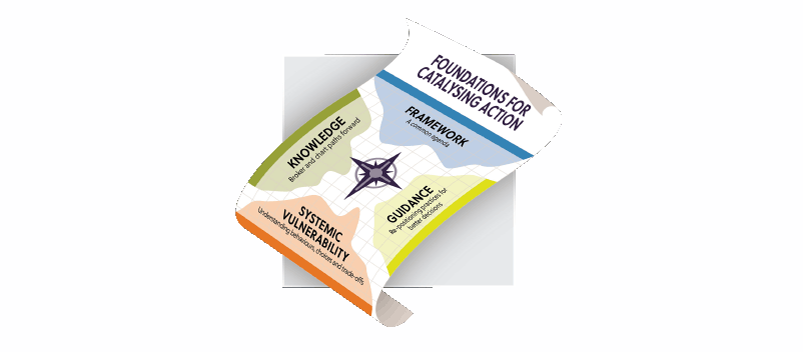The National Resilience Taskforce, established in April 2018, provided the national direction needed to underline climate and disaster risk and improve national resilience across all sectors in Australia. The work is anchored in the Sendai Framework for Disaster Risk Reduction 2015–20301, the Sustainable Development Goals2 and the Paris Agreement3, which work towards a resilient and sustainable society by 2030.
The significance of drivers for action require genuine national coordination, information and guidance to ensure all relevant decision-makers have the information and decision-support tools necessary to meet this challenge.
These drivers include:
- natural hazards are more frequent and intense
- essential services are interconnected and interdependent
- people and assets are more exposed and vulnerable
- disaster impacts are long-term and complex
- the costs of disasters are growing
- the momentum to address the financial impacts of a changing climate is building.
New ways to understand disaster risk
Based on these drivers our understanding of disaster risk has evolved in four important ways:
- Systemic vulnerability needs to be addressed.
The most effective way to reduce disaster risk is to address systemic vulnerability. In Australia we tend to understand and manage disaster risk by focusing on individual hazards instead of systemic vulnerability. The vulnerability of our communities is largely created by our dependence on critical infrastructure and services, and the inter-dependencies among these. - Better decision-making is key to preventing and reducing disaster risk.
To reduce the impacts of disasters, we must understand the points where risk is created. Traditionally, we have focused on resilience – ensuring Australians can ‘bounce back’ from disaster – but this is the point where harm is experienced, not the point at which the risk of harm is created.
Decisions taken at multiple levels by different actors – whether local, state or industry – affect our disaster risk. These include decisions around land-use planning, building standards and infrastructure design, urban and regional development and asset management and investments. Failing to adequately consider future risks in early decisions facilitates further risk creation, on top of risks already embedded in society and the landscape.
Continuing to focus on resilience of particular assets, or individuals and communities, who do not control many of the levers needed to reduce disaster risks, is not enough. - A suite of options is needed to address disaster risk.
When considering how to reduce risk, does it make most sense to harden, adapt or transform? A suite of options is important, as a particular response may work in one circumstance but may not be appropriate in another, and may not be effective over the long-term. - There is an interdependency between disaster risk reduction and climate adaptation.4
Disaster risk reduction and climate adaptation policies need to be developed together to comprehensively address the causes of disaster risk. In Australia, we have predominantly focused on responding to disasters triggered by hazardous events that emerge quickly such as flooding, cyclones and bushfires.
However, to achieve sustainable disaster risk reduction, we need to consider events that emerge gradually such as drought, desertification, sea-level rise and epidemic disease, and how climate is changing our understanding of hazards. Embedding disaster risk reduction and climate adaptation, can reduce disaster risk more comprehensively, rather than just dealing with the emergency management issues of immediate sudden-onset disasters.

Image: Understanding disaster risk is a combination of four important foundations.
The way forward
Key policy priorities to take forward include:
- improving climate and disaster risk information for long-term decisions
- embeding climate and disaster risk-informed thinking in government and industry funding programs and generate additional private sector investment
- understanding and quantifying the benefits of risk reduction and how to generate a return, even if a disaster does not occur
- refining and supporting others to implement strategic risk guidance across sectors to ensure it delivers exactly what our decision-makers need to make better decisions, mindful of their role in reducing risk and building resilience
continuing to develop policy capability and aligning climate adaptation and disaster risk reduction policies.
The National Resilience Taskforce has been developing foundational work to meet these priorities. A new strategic Guidance for Strategic Decisions on Climate and Disaster Risk5 supports decision-makers to consider uncertainty about future climate and disaster risk through scenario thinking and scenario analysis. It explains how to identify and assess the causes and effects of vulnerability, and points to what can be done to reduce these. It puts forward new concepts and an accessible process for investors to identify opportunities to create and capture value to incentivise investment, and it provides for the first time a framework to prioritise investments and know where to focus efforts to achieve the greatest economic returns from the greatest reduction in vulnerability.
The National Resilience Taskforce explored the feasibility of establishing a new national climate and disaster risk information capability, to translate scientific information about hazards, exposure, vulnerability and climate into decision-useful information. The capability will leverage and coordinate the existing scientific and technical capabilities across the Commonwealth and connect with state and territories through centralised coordination but with decentralised delivery. The capability could offer information about climate and disaster risks, across all time scales, for all kinds of decisions across government, industry, community and households.
The new National Disaster Risk Reduction Framework6 reflects this understanding of disaster risk and sets the action needed for decision-makers across all sectors of the Australian economy to reduce risk in their control.
Publicly released on 5 April 2019, implementation of the framework at the national level is ongoing. The Australia-New Zealand Emergency Management Committee has endorsed the framework and has recommended that the Ministerial Council for Police and Emergency Management endorse the framework at its next meeting in mid-2019, which in turn will drive its national implementation including preparing a national statement of action.


